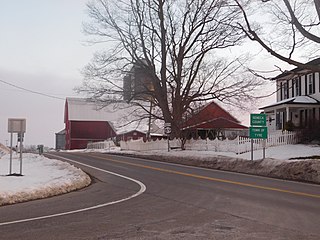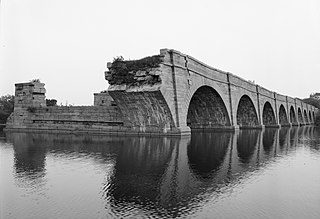
The Erie Canal is a historic canal in upstate New York that runs east–west between the Hudson River and Lake Erie. Completed in 1825, the canal was the first navigable waterway connecting the Atlantic Ocean to the Great Lakes, vastly reducing the costs of transporting people and goods across the Appalachians. In effect, the canal accelerated the settlement of the Great Lakes region, the westward expansion of the United States, and the economic ascendancy of New York State. It has been called "The Nation's First Superhighway."

Tyre is a town in Seneca County, New York, United States. The population was 1,002 at the 2020 census. The town is named after the Lebanese city of Tyre.

Clyde is a village in Wayne County, New York, United States. The population was 2,093 at the 2010 census. It was named after the River Clyde, in Scotland, and the village sits on the Clyde River, a tributary of the Seneca River.

Newark is a village in Wayne County, New York, United States, 35 miles (56 km) south east of Rochester and 48 miles (77 km) west of Syracuse. The population was 9,017 at the 2020 census. The Village of Newark is in the south part of the Town of Arcadia and is in the south of Wayne County. It is the most populous community in Wayne County.

Macedon is a town in Wayne County, New York, United States. The population was 9,148 at the 2010 census.

Palmyra is a village in Wayne County, New York, United States. The population was 3,536 at the 2010 census. The village, along with the town, is named after Palmyra in present-day Syria.

Palmyra is a town in southwestern Wayne County, New York, United States. The population was 7,975 at the 2010 census. The town is named after the ancient city Palmyra in Syria.

The Ohio and Erie Canal was a canal constructed during the 1820s and early 1830s in Ohio. It connected Akron with the Cuyahoga River near its outlet on Lake Erie in Cleveland, and a few years later, with the Ohio River near Portsmouth. It also had connections to other canal systems in Pennsylvania.

The Old Erie Canal State Historic Park encompasses a 36-mile (58 km) linear segment of the original Erie Canal's Long Level section. It extends westward from Butternut Creek in the town of DeWitt, just east of Syracuse, to the outskirts of Rome, New York. The park includes restored segments of the canal's waterway and towpath which were in active use between 1825 and 1917. It is part of the New York State Park system.

The Erie Canal Museum is a historical museum about the Erie Canal located in Syracuse, New York. The museum was founded in 1962 and is a private, non-profit corporation. It is housed in the Syracuse Weighlock Building dating from 1850. The Syracuse Weighlock Building was in operation as a weighlock from 1850 to 1883. In 1883 the canal decided to stop charging tolls. The weighlock building was essentially used as a big, elaborate scale to weigh the boats traveling on the Erie Canal and determine how much each boat would pay for a toll. Today the museum includes not only artifacts from the Erie Canal, but also a gallery of present canal life. It is the mission of the museum to help people to learn the rich history of the Erie Canal and that it is not just a thing of the past, but still very much exists today in different forms.

The Morgan–Manning House is a historic house located in Brockport, Monroe County, New York. It was built in 1854 and is a two-story, Italianate–style brick dwelling on a limestone foundation. The five-by-four-bay main block features a hipped roof and cupola. It has a two-story hipped roof wing with a smaller two-story brick appendage creating a stepped, or telescoping, plan or profile. The house also has a full width porch with brick piers. The interior features elaborate interior woodwork, period plasterwork, stained glass and decorated ceilings. Also on the property is a contributing carriage house.

Schoharie Crossing State Historic Site, also known as Erie Canal National Historic Landmark, is a historic district that includes the ruins of the Erie Canal aqueduct over Schoharie Creek, and a 3.5-mile (5.6 km) long part of the Erie Canal, in the towns of Glen and Florida within Montgomery County, New York. It was the first part of the old canal to be designated a National Historic Landmark, prior to the designation of the entire New York State Barge Canal as an NHL in 2017.

Camillus Erie Canal Park is a town park in Camillus, New York that preserves a seven-mile (11 km) stretch of the Erie Canal. It includes the Nine Mile Creek Aqueduct, which is listed on the National Register of Historic Places. The aqueduct underwent a $2 million restoration, completed in August 2009, which brought it back to navigable condition.
Parks & Trails New York is New York's leading statewide advocate for parks and trails, dedicated since 1985 to improving our health, economy, and quality of life through the use and enjoyment of green space.

Day Peckinpaugh is a historic canal motorship berthed at the Matton Shipyard on Peebles Island, Cohoes in Albany County, New York, United States.

Lyons is a hamlet in Wayne County, New York, United States. The population was 3,619 at the 2010 census. It is located in the southern half of the town of Lyons. The hamlet and the town are named after Lyon, France. Originally named "The Forks", Lyons was renamed by land agent George Williamson.

Lyons is a town in Wayne County, New York, United States. The population was 5,682 at the 2010 census. It is named after Lyon, France.

The New York State Canalway Trail is a network of multi-use trails that runs parallel to current or former sections of the Erie, Oswego, Cayuga-Seneca, and Champlain canals. When completed, the system will have 524 miles (843 km) of trails following current and former sections of the canals. The longest of these is the 365 miles (587 km) long Erie Canalway Trail. The Erie and Champlain Canalway Trails are also part of the statewide Empire State Trail system.

Blackstone River Valley National Historical Park is a National Park Service unit in the states of Rhode Island and Massachusetts. The park was created for the purpose of preserving, protecting, and interpreting the industrial heritage of the Blackstone River Valley and the urban, rural, and agricultural landscape of that region. The Blackstone River Valley was the site of some of the earliest successful textile mills in the United States, and these mills contributed significantly to the earliest American Industrial Revolution. The subsequent construction of the Blackstone Canal, a few years after the successful completion of the Erie Canal, helped to sustain the region's industrial strength.
















